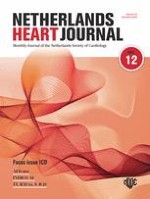What’s new?
Introduction
Methods
Statistical analysis
Results
Number of patients | |
|---|---|
Pacemaker indication
| |
AVB I° with severely prolonged QT-duration and complete left bundle branch block | 13 (7.7%) |
AVB II° type Mobitz II | 8 (4.8%) |
AVB III° | 118 (70.2%) |
Trifascicular block | 4 (2.4%) |
Alternating complete right and left bundle branch block | 6 (3.6%) |
Bradyarrhythmia with atrial fibrillation | 17 (10.1%) |
Sinus arrest | 1 (0.6%) |
Resuscitation due to ventricular fibrillation | 1 (0.6%) |
Device type
| |
VVI-Pacemaker | 34 (20.2%) |
DDD-Pacemaker | 123 (73.2%) |
Implantable cardioverter defibrillator (2-chamber) | 2 (1.2%) |
Cardiac resynchronisation therapy—pacemaker | 9 (3.0%) |
Cardiac resynchronisation therapy—defibrillator | 4 (2.3%) |
No-PPMI | PPMI | P-Value | |
|---|---|---|---|
Number of patients | 444 | 168 | |
Age, years | 80.1 ± 6.1 | 81.1 ± 5.5 | 0.08 |
Female | 244 (55.0%) | 80 (47.6%) | 0.11 |
BMI (kg/m2) | 26.9 ± 4.6 | 27.2 ± 5.0 | 0.48 |
NYHA functional class III/IV | 350 (81.1%) | 127 (75.6%) | 0.13 |
Diabetes mellitus | 140 (31.5%) | 43 (25.6%) | 0.15 |
Severe chronic renal failure | 43 (9.7%) | 20 (11.9%) | 0.42 |
Coronary artery disease | 268 (60.8%) | 106 (63.5%) | 0.54 |
History of myocardial infarction | 60 (13.5%) | 24 (14.3%) | 0.80 |
History of cardiac surgery | 47 (10.6%) | 15 (8.9%) | 0.64 |
History of stroke or intracerebral bleeding | 45 (10.1%) | 18 (10.7%) | 0.83 |
Pulmonary disease (moderate or severe) | 189 (42.8%) | 78 (46.7%) | 0.38 |
History of atrial fibrillation | 154 (34.7%) | 66 (39.3%) | 0.30 |
EuroSCORE II, % | 6.2 ± 5.8 | 6.3 ± 5.5 | 0.84 |
STS PROM, % | 6.6 ± 4.8 | 6.7 ± 5.2 | 0.89 |
Echocardiographic data
| |||
Aortic peak gradient, mm Hg | 64.1 ± 22.4 | 66.1 ± 23.3 | 0.33 |
AVA indexed, cm2/m2 | 0.28 ± 0.08 | 0.28 ± 0.08 | 0.54 |
Left ventricular ejection fraction (%) | 57.1 ± 15.4 | 58.0 ± 14.7 | 0.51 |
Left ventricular ejection fraction <45% | 94 (21.2%) | 30 (17.9%) | 0.36 |
Procedural data
| |||
Implanted valve type: | |||
– Boston Lotus/Lotus Edge | 127 (28.6%) | 98 (58.3%) | <0.01 |
– Edwards Sapien 3 | 294 (66.2%) | 66 (39.3%) | <0.01 |
– Medtronic CoreValve Evolut | 23 (5.2%) | 4 (2.4%) | 0.13 |
Paravalvular aortic regurgitation | |||
– None/trace | 343 (77.3%) | 129 (82.7%) | 0.14 |
– Mild | 101 (22.8%) | 29 (17.3%) | |
– Moderate/severe | 0 | 0 | |
Device success | 410 (92.3%) | 154 (91.7%) | 0.78 |
Outcome at thirty days
No-PPMI | PPMI | P-Value | |
|---|---|---|---|
Number of patients | 442 | 168 | |
Major adverse events | 4.3% | 4.2% | 0.95 |
All-cause mortality | 1.1% | 1.8% | 0.53 |
Stroke or transient ischaemic attack | 1.4% | 0.6% | 0.43 |
– Stroke | 0.2% | 0.6% | 0.47 |
– Transient ischaemic attack | 1.1% | 0% | 0.17 |
Myocardial infarction | 0% | 0% | – |
Bleeding | 0.5% | 0.6% | 0.82 |
Aortic dissection | 0% | 0.8% | 0.10 |
Aortic valve thrombosis or endocarditis | 0% | 0% | – |
New onset of atrial fibrillation | 0% | 0% | – |
Rehospitalisation | 2.8% | 1.8% | 0.51 |
Outcome at one year
No-PPMI | PPMI | P-Value | |
|---|---|---|---|
Number of patients | 385 | 147 | |
Major adverse events | 22.1% | 24.5% | 0.55 |
– Only Boston Lotus valve – Only Edwards Sapien 3 | 24.3% 19.8% | 19.4% 29.6% | 0.43 0.12 |
All-cause mortality | 12.5% | 12.2% | 0.94 |
– Only Boston Lotus Valve – Only Edwards Sapien 3 | 9.9% 14.3% | 13.6% 11.3% | 0.43 0.53 |
Stroke or transient ischaemic attack – Stroke – Transient ischaemic attack | 5.5% 3.9% 1.8% | 8.9% 4.1% 4.8% | 0.15 0.91 0.06 |
Myocardial infarction | 0.5% | 0.7% | 0.82 |
Bleeding | 2.6% | 2.7% | 0.93 |
Aortic dissection | 0% | 0.7% | 0.1 |
Aortic valve thrombosis | 0.5% | 0.7% | 0.82 |
Endocarditis of the prosthetic aortic valve | 0% | 0.7% | 0.10 |
New onset of atrial fibrillation | 0.8% | 0.7% | 0.91 |
Rehospitalisation | 18.1% | 16.1% | 0.63 |
